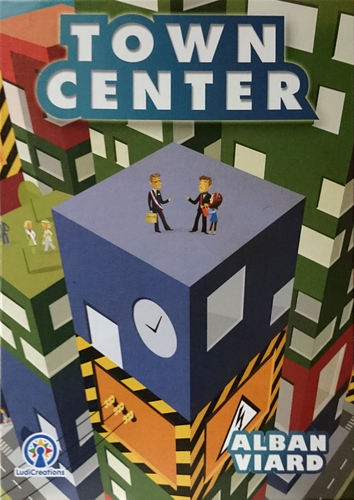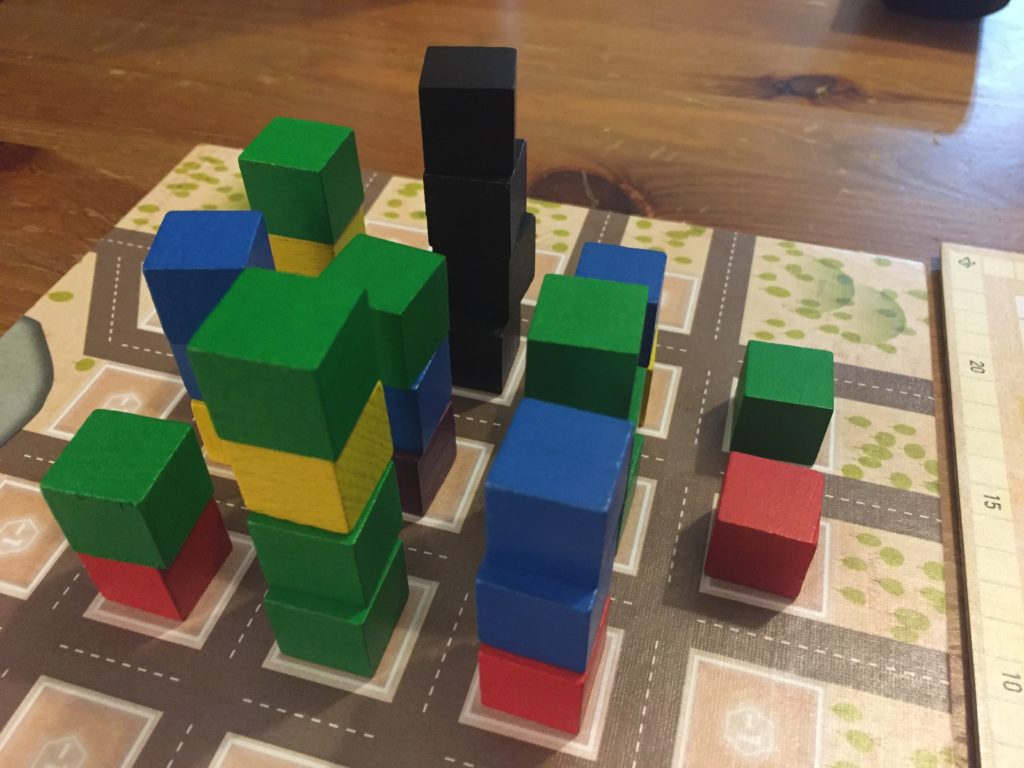I had a weakness for city builders ever since I laid my hands on SimCity for the SNES. There’s nothing more satisfying than getting a population of 500,000 people, saving, and then calling in every natural disaster the game has to offer. There aren’t any tornadoes in “Town Center”, nor will Godzilla show up to Hulk-Smash everything to tiny pieces. Still, players will be able to earn victory points for how well they manage their town through the process of drafting and placing cubes.

Town Center: 1-4 Players*, Ages 12+, Average Play Time = 30 Minutes
*The box says 2-4 players, but there is a solo variant and solo score table in the manual.
Components
The game includes 4 double-sided player boards, 1 double-sided central/solo board, various large building and small player cubes, a cloth bag, and a manual.
Setup & Gameplay
Players each get a player board, pick the same side, and place a small cube of their player color (their choice) onto the $3 spot on the income track of the central board. A number of cubes are placed in the cloth bag depending on the number of players…the rest go into a reserve. Each player gets a large purple cube (town hall/office) and places it on any building spot on their player board.
The game is broken up over a series of rounds, with each round consisting of five phases:
1. Investment – The active player pulls cubes from the bag equal to the number of players times two, then stacks them into towers on the table two-high any way they’d like. For the first round, office cubes are re-drafted. Starting with the active player and going clockwise, they choose the top-most cube from one of the towers. This continues until everyone has two cubes.
2. Construction – The players place the cubes they earned from phase one onto their boards, though there are some restrictions. Green residential cubes cannot be placed adjacent to green cubes, nor can blue commercial cubes be placed adjacent to blue cubes. Players must pay $5 to place a red office cube and grey cubes one-high act as parking lots while grey cubes 2+-high act as elevators. Elevators determine the maximum height players can stack their cubes throughout their town. Elevators need to be powered by yellow utility cubes however in order to work. Cubes in the suburbs can only be stacked one-high.
3. Development – Residential green cubes spawn another green cube based on the number of red office cubes touching it. A residential unit of one cube needs two or more offices adjacent to it to spawn another green cube, a residential unit of two cubes needs three adjacent red office cubes, and so on. Commercial blue cubes will develop based on the number of residential units (not cubes) touching it. A commercial unit of one cube will develop if two residential units are adjacent, and so on. A unit is simply more than one cube of the same cube color that are adjacent to one another.
4. Tax Revenue – Each player gets $1 automatically per round. Powered commercial cubes earn money for both its size and height (there’s a chart on the central board). Parking lots generate $1 for each cube adjacent to it (maximum of $4) and do not need to be powered.
5. Public Works – In reverse player order, players may pay money (the cost varies) to buy one yellow or one black elevator cube from the reserve.
Once the round is over, the bag of cubes is passed clockwise who becomes the starting player. Once the bag is out of cubes and the final round plays out, the game is over. Players earn one point for every $5 they have, as well as points for their powered residential units based on size and height (there’s a chart on the central board). They lose a point for each cube built in the suburbs. The player who has the most points, wins the game!
Editor’s Note: The above doesn’t cover all of the rules found in the manual, but should give you an idea as to how the game is played.

The Review
I’ve had my eye on this one for quite a while and would have grabbed it sooner, had it not been so hard to buy. Eventually I found it on Miniature Market for about $40 which is a bit steep for my tastes. Then again, you’re getting a LOT of cubes with this game and the quality of the components is fairly good. The player boards are two-sided and there’s even a separate solo board on the reverse side of the central board should you wish to use it, though you can play solo on the standard player boards too.
The rules are a bit confusing, especially when it comes to earning money and scoring. During the tax revenue phase, for example, players earn money for powered commercial units based on size and height (separately). Three cubes next to each other on the ground floor score $1 + $2 + $3 (size), while cubes on the second floor add $1 to the revenue, cubes on the third floor add $2 to the revenue, and so on. So a commercial unit of four cubes that reaches the third floor earns $1 + $2 + $3 + $4 (size) + $1 + $2 (height). Thank goodness for the chart on the central board or I’d be miscalculating quite a bit.
“Town Center” is deceptively simple in that it’s easy to play once you get a handle on the rules. However, it may take a few games and possibly some research to understand some of the specifics. For example, I couldn’t determine if two grey cubes that were stacked still earned income. I knew that the pairing became an elevator as soon as the second cube stacked, but I didn’t know if the bottom-most cube still earned money as if it were a parking lot. I later determined through research that once a parking lot turned into an elevator then it didn’t generate any more money.
I might not be very good at the game right now, but I often pull it out of my closet to play a solo game just to see if I can do better than the last time I tried it. In some ways, this game seems more like a puzzle game than a city-builder since you’re limited on the building types you can place every round and you may not get the ones you want via the drafting process. “Town Center” warrants your attention if you have the patience to learn the tax/scoring system, as well as how buildings automatically sprawl during development. Otherwise, you might want to try a city-builder that is a bit more straight forward, even if it takes longer to play.
Final Verdict: 7/10
—
